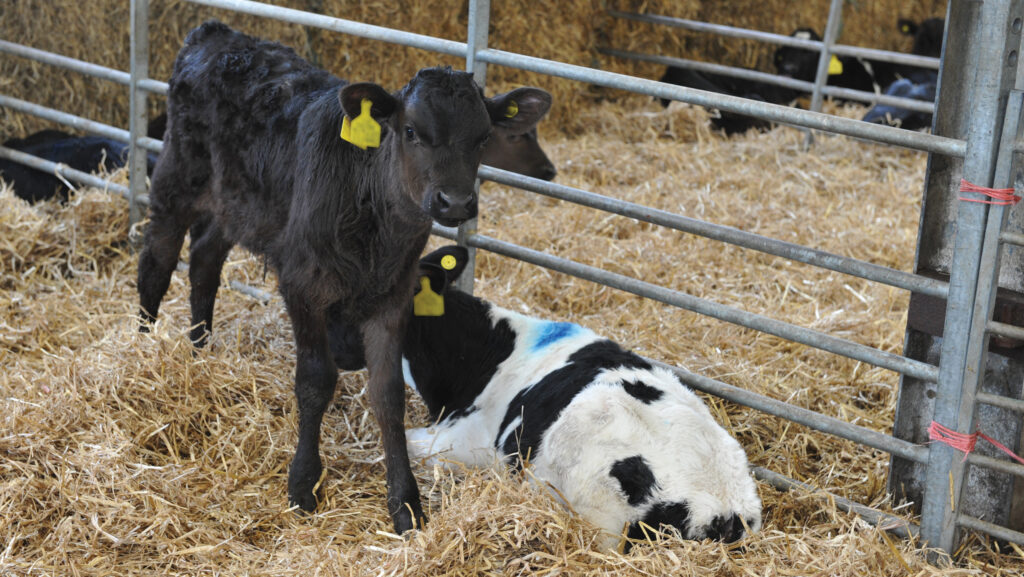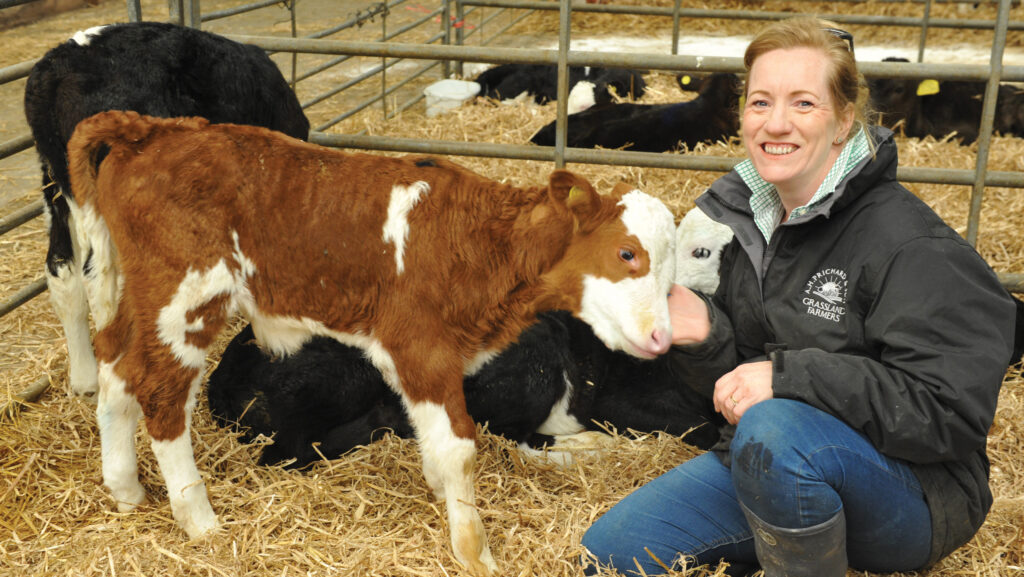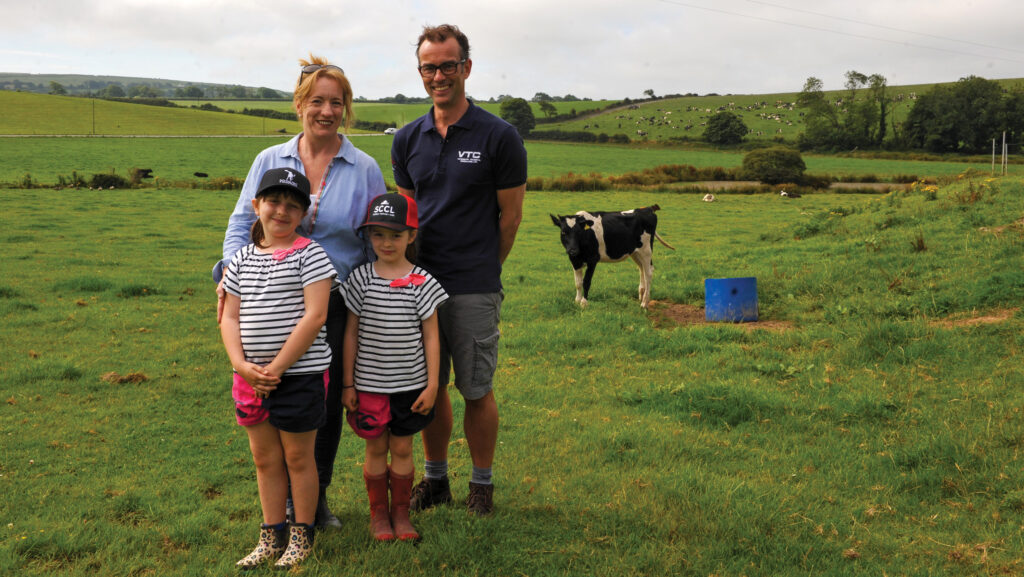Feeding transition milk to calves cuts mortality by 68%
 © Debbie James
© Debbie James Feeding transition milk to newborn calves in their first 10 days and enriching it according to their immunoglobulin G status have helped a Pembrokeshire dairy farm slash pre-weaning mortality rates by two-thirds.
Will and Alex Prichard calve 500 cows in a spring block at Escalwen, near Letterston, and also run two 200-cow autumn-calving herds.
See also: 4 ways to improve on 60-day calf mortality rate
That high throughput of calves can present disease challenges: in the three years to 2023, calf mortality from neonatal diarrhoea averaged 9.5%, peaking at 16% in 2022 when the herd was subject to bovine TB movement restrictions.
Will says: “Over my entire farming career, one of the most depressing things I have experienced is when calf rearing goes wrong and when mortality and sickness in calves becomes almost insurmountable.”
In 2023, in an attempt to correct weaknesses in their system, the Prichards and their calf rearer, Tom Phillips, embarked on a new feeding programme guided by veterinary consultant Ryan Davies.
They invested in two pasteurisers, part funded by the Welsh government’s Small Grants – Efficiency scheme.
These were used to feed cow transition milk enriched with whole bovine powdered colostrum after calves had received their colostrum feed.

Alex Pritchard © Debbie James
Transition milk
Transition milk is produced by the cow from the second milking after calving up to the sixth. It contains a higher percentage of milk solids, antibodies, vitamins and minerals than milk produced after this point in the lactation.
It also has elevated levels of growth factors, natural antimicrobial proteins and other bioactive substances.
However, the quality of transition milk is highly variable. That, in conjunction with the transfer of passive immunity (TPI) from colostrum, which dictates a calf’s antibody levels, will make a significant difference to health and performance.
If calves do not receive sufficient antibodies, they are more likely to die, suffer from diarrhoea or respiratory issues, and require treatment with antibiotics.
One solution is to take blood samples from calves and use immunoglobulin G (IgG) as a biomarker to standardise transition milk.
This is what the Prichards did, supported by the Farming Connect Try-Out Fund, an initiative that helps individuals and groups of farmers and growers to experiment with ideas and bring them to life.
Throughout the calving season, Ryan took daily blood samples from newborn calves in their first 24 hours. The results showed that 21% had an excellent TPI, 7% were rated good, 41% were fair and 31% poor.
“This is about average for the UK and good for a dairy block calving herd,” says Ryan, of Veterinary Technical Consulting.

Alex Pritchard (with daughters Florence and Jemima) and vet Ryan Davies © Debbie James
Nutritional quality
The total solids component in the pasteurised transition milk was measured with a Brix refractometer.
Depending on the reading, it was enriched with a colostrum powder from colostrum company SCCL to standardise it to a minimum of 12.5% Brix or 14.5% milk solids. (Instead of using powder, another option is to add whole milk colostrum.)
“If we didn’t reach that threshold, we added whole bovine colostrum powder to it to increase the Brix reading,” Ryan explains.
“The average Brix for the milk at Escalwen was 10.5%, so we raised that to 12.5% – but every farm will be different.”
Other parameters set were to only use milk with a total bacterial count of less than 100,000 colony-forming units (cfu)/ml, a total coliform count of less than 10,000 cfu/ml, and no antibiotics residues.
“It is important that calves aren’t fed any antibiotics residues because they inhibit the growth of the normal healthy gut microbiome,” he says.
The milk was fed to calves up until day 10.
Health outcomes
This approach resulted in a significant improvement in calf health and a major reduction in mortality.
Death from neonatal diarrhoea reduced from an average of 9.5% to 3% and antibiotics use in pre-weaned calves to 16%, from the five-year average of 45%.
Comparison of calf mortality and antibiotics use at Escalwen |
|||
|
Average calf mortality from neonatal diarrhoea |
Percentage of pre-weaned calves treated with antibiotics |
Use of highest priority critically important antibiotics (mg/PCU) |
|
|
Three years to 2023 |
9.5% |
45%* |
1.98 |
|
Following introduction of new feeding programme in 2023 |
3% |
16% |
0 |
| Source: Farming Connect | |||
Importantly, no highest-priority critically important antibiotics (HP-CIA) were used pre-weaning in 2024; in 2022, use of these had hit a high of 1.98mg/population correction unit (PCU).
Although feeding transition milk comes with some additional cost, from labour and equipment for its collection through to storage and heating, Ryan says the improvements completely changed the mood on the farm during the calving period.
“Once you get your head around how important IgGs are, it almost becomes a passion to harvest as much of that IgG as you possibly can and utilise it in your own herd,” he says.
As well as transition milk feeding, improvements were made to hygiene and cleanliness to reduce the disease challenge.
Why pasteurise milk for calves?
Pasteurising the milk was a “game changer” in improving calf health at Escalwen, reducing disease risks such as Johne’s and bovine TB, according to vet Ryan Davies.
The milk was pasteurised for 60 minutes at 60C to destroy pathogens including mycoplasma, salmonella, E coli and listeria.
Pasteurising at higher temperatures or for a longer duration can reduce antibody levels, although studies have shown this is more effective in the destruction of Johne’s and bovine TB organisms, which can still be detected after heating to 60C for 60 minutes.
Top tips for feeding transition milk
- Adhere to good hygiene practices when collecting and storing prior to feeding
- Heat to the correct temperature before feeding
- Take the health status of the herd into account to reduce risk of disease transfer, particular if pasteurisation is not used
- In systems that feed calf milk replacer instead of whole milk, the equivalent mass of milk powder should be removed and replaced with colostrum powder to maintain the solids percentage and prevent osmotic diarrhoea
